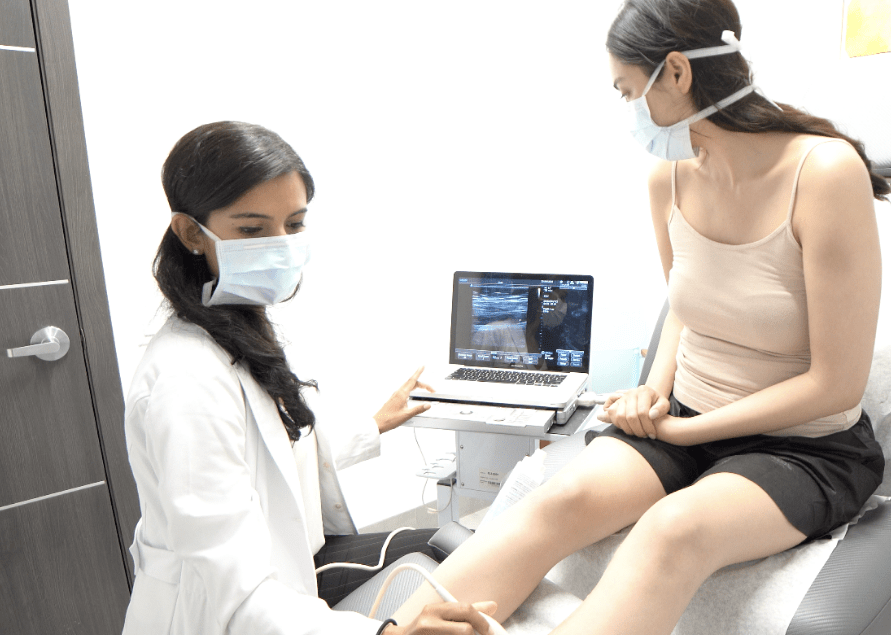How long does sclerotherapy take to work?
Sclerotherapy is a minimally invasive spider vein treatment. The procedure involves injecting a sclerosing agent into the diseased spider veins using ultrafine needles. The sclerosing agent fuses the spider veins’ walls, turning them into hardened scar tissues eventually metabolized and reabsorbed by the body. Once the spider veins are reabsorbed by the body, they fade away from the skin’s surface, making your legs look smooth and even-textured. Sclerotherapy is an extremely effective procedure for spider veins and small varicose veins, but how long it takes to work depends on numerous factors.
After sclerotherapy, the diseased spider veins will harden into scar tissues. You will experience mild post-treatment redness, swelling, tenderness, and bruising around the injection sites for a few days. Once the spider veins harden into scar tissues, they’ll seem to have worsened — they’ll look darker and feel harder against your skin. But that’s a part of the process. Over time, your body will metabolize the scar tissues, making them fade away from the skin’s surface. The entire procedure takes around 3 weeks for spider veins and a few months for varicose veins.
Sclerotherapy is generally a quick and simple procedure that takes less than 30 minutes to complete. The injections are usually given in a series of 3-4 sessions, spaced 4-6 weeks apart. It usually takes 2-3 weeks for the treated veins to start disappearing and 4-6 weeks for the full results to be seen. In some cases, additional treatments may be necessary to achieve the desired results. If you have underlying chronic venous insufficiency, your vein doctor may also recommend other vein treatments to minimize the risk of recurrence.
Long Island Vein Treatment is a group of state-of-the-art medical centers for vein treatment in Long Island. We have state-of-the-art offices in West Islip, Jericho, and the Hamptons. Our West Islip office is close to the Bergen Point Golf Course, the Jericho office is right off of the Long Island Expressway, and the Hamptons office is in Hampton Bays. Our vein doctors always offer comprehensive treatments for spider veins to ensure safe and long-lasting results with minimal or negligible risk of recurrence.
Please schedule an appointment to explore your sclerotherapy options in Long Island.

How long does it take for veins to close after sclerotherapy?
Veins that are treated with sclerotherapy will usually start to show improvement within a few days. The treated veins will gradually get smaller and less visible. Depending on the size and location of the spider veins and small varicose veins, it can take several weeks or months for the veins to disappear completely. Most people only require one or two treatment sessions to see significant results. However, some people may need additional treatments to achieve the desired results.
How do you know if sclerotherapy is working?
After your sclerotherapy session, it might seem like your spider veins are worsening. That’s because your spider veins will harden into scar tissues that are gradually metabolized by the body. As such, your spider veins will initially look darker and harder before fading away from your skin’s surface. Once the spider veins start getting metabolized, the treated veins will start to fade in color. They may also become smaller and less visible. You will also have less pain and discomfort in the treated area.
Does sclerotherapy look worse before it gets better?
Sclerotherapy involves injections of a solution directly into the veins. The solution irritates the lining of the vein, causing it to swell and stick together, and eventually, the vein will fade away. Spider veins often look worse before they start to improve. This is because the injection causes the veins to become darker and more visible. The veins will eventually fade away, but this can take several weeks or months.
How do I get the best results from sclerotherapy?
The best results from sclerotherapy can be achieved by working with a board-certified phlebologist or vein specialist. Before your treatment, it is important to avoid sun exposure, sun tanning, and heat treatments (such as saunas and hot baths) for at least one week. These can increase the risk of complications. You should also stop taking any blood thinning medications (aspirin, ibuprofen, etc.) for at least one week prior to your treatment.
During your treatment, a small amount of a sclerosing agent is injected into the affected vein. The solution works to damage the vein wall, causing it to collapse and eventually disappear. Multiple injections may be necessary, and the entire process usually takes less than an hour. After your treatment, you will need to wear compression stockings for 1-2 weeks. These help to keep the injected veins closed and reduce the risk of complications. You should avoid strenuous activity and sun exposure for 1-2 weeks.
What happens if I don’t wear compression stockings after sclerotherapy?
If you’ve recently had sclerotherapy to treat varicose or spider veins, your doctor probably told you that it’s important to wear compression stockings for a period of time afterward. But what happens if you don’t wear them?
It’s not uncommon for people to experience mild discomfort, itching, or burning after sclerotherapy. These symptoms are usually worse within the first 24 hours, but they should start to improve after that. Wearing compression stockings can help to reduce these symptoms. Compression stockings also prevent your veins from getting worse. By applying gentle pressure to your legs, they keep your veins from expanding and filling with blood.
If you don’t wear compression stockings after sclerotherapy, you may be at risk of developing new spider or varicose veins. You may also have a higher chance of developing blood clots in your treated veins. So, while it may be tempting to skip the compression stockings, it’s important to wear them as directed by your doctor. Doing so will help you to get the most out of your treatment and avoid potential complications.